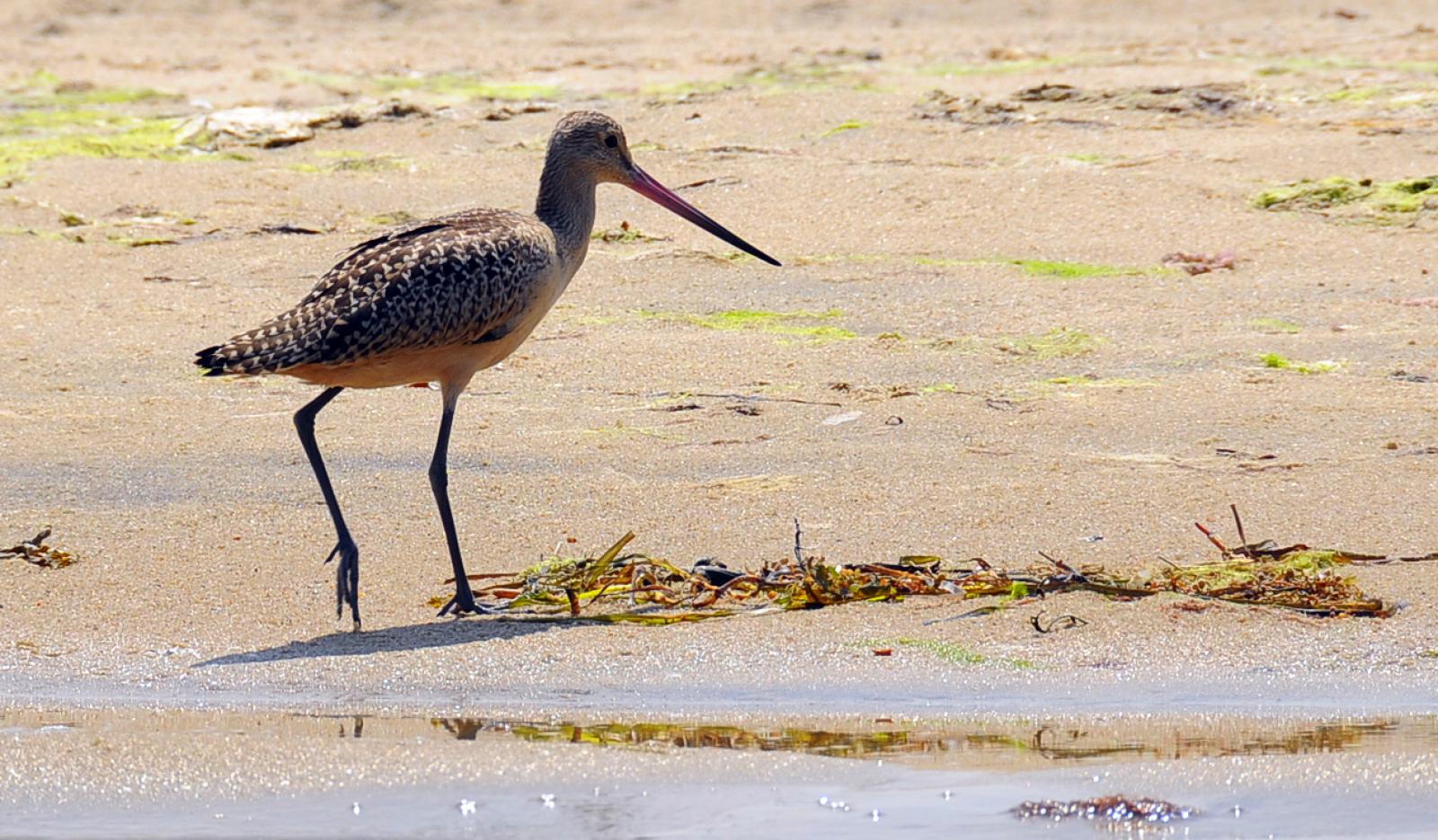The Chilmark Community Center birding group had the pleasure of driving out on Norton Point with Nan Harris on August 4. Page Rogers had e-mailed photos of a marbled godwit that she had taken the day before at Norton Point. Marbled godwits are rare visitors to the Vineyard with only five records prior to this one, so this trip was to target the marbled godwit.
Our group spotted the marbled godwit, five species of terns including the gull-billed tern. This tern, also with only five previous records, is another rare Vineyard visitor. We saw the gull-billed tern first as it was flying with a common tern. It then settled in with the huge flock of loafing terns including black, common, least and roseate terns and disappeared from view in the masses. We also spotted one piping plover in with the semipalmated plovers and least and semipalmated sandpipers. Ruddy turnstones and short-billed dowitchers along with young and adult American oystercatchers and willets were also feeding on the Katama Bay flats. We watched two black skimmers skimming about three feet from us. A great treat and we thank Nan for affording us this opportunity!
An old roommate from college days and a nonbirder commented on Facebook that I had made up the name marbled godwit. I told her that I had not but that ornithologists of yore had. That led me to puzzle out where the name godwit came from. The Audubon Society’s Encyclopedia of North American Birds states that the godwit’s origin was probably derived from an Old English phrase “god wicht” which loosely translated means “good creature.” Why a good creature? Because in the 15th and 16th centuries, the godwits were hunted and appeared on menus as a delicacy. The marbled is surely for its mottled plumage.
A large shorebird common on the Pacific and Gulf coasts of the United States, the marbled godwit is rarely seen in the Northeast and then only a single bird or small numbers. The largest flock seen on the Vineyard was 12 birds seen on the shores of Sengekontacket after a storm in 1994.
Bird Sightings
Bob Shriber was watching both Cory’s and greater shearwaters along with Wilson’s storm petrels while he was fishing at Lobsterville on July 28 and 29.
Tim Simmons and Paul Goldstein were observing Tiger beetles at Squibnocket and spotted a ruddy turnstone in with the least and semipalmated sandpipers and plovers. They also spotted a willet and an American oystercatcher. They found a few common and least terns still feeding fledglings.
The mystery, oddly-colored bird, which Joan Jenkinson described as a black bird with a white handkerchief tied around its neck, has been identified. The bird which has been frequenting Herb Moody’s feeder with an occasional foray to Roberta and Kevin Hearn’s yard has been identified as a leucistic common grackle. Lanny McDowell blew up a photograph that Roberta took and figured the body and the bill shapes were correct for the common grackle. Teamwork: isn’t it grand!
Ginny Jones spotted a great egret in the Mill Pond in West Tisbury on July 31. I was chatting with many of the Vineyard birders last night and we all noted that we are seeing more great egrets than snowy egrets this year. On Tisbury Great Pond Dotty and Don Gonson have been watching two great egrets and a great blue heron feeding on Big Sandy almost daily. On occasion Flip Harrington and I can see three great egrets perched in the pines on Spalding’s Point on Short Cove.
Dale Carter spotted two great egrets, three snowy egrets and three willets feeding in a salt pan with crows in the marshes by the Dyke Bridge on Chappaquiddick on August 2.
Spotted sandpipers have been feeding along the shores of Tisbury Great Pond this last week.
On July 30 Flip Harrington and crew spotted a black tern, 50 to 60 Cory’s, four greater and one sooty shearwater and 50 Wilson’s storm petrels while fishing off Gay Head. The following day Flip and Bob Shriber saw all the same species except the sooty shearwater. On August 1 Flip Harrington and crew had the same bird species and the fishing was good. On August 3, the birds were not seen and the fishing was terrible. No birds, no bait, no fish!
On July 31 Lanny McDowell, Bob Shriber and I birded Tisbury Great Pond flats. Our best bird was a stilt sandpiper. We also spotted four whimbrels and counted twenty piping plovers.
Mike Seeger found a dead adult northern gannet on Squibnocket Beach on August 4. Nick Bayer called to say he found a young osprey that had died at Sepiessa. There is always death in young and old birds annually. It is upsetting when you happen to be the one to find them.
Page Rogers photographed red knots and ruddy turnstones on the shores of Sengekontacket Pond on August 2. One of the knots was banded. I will try to find out where these birds came from. Stay tuned.
Please report your bird sightings to the Martha’s Vineyard Bird Hotline at 508-627-4922 or e-mail to birds@mvgazette.com.




Comments
Comment policy »